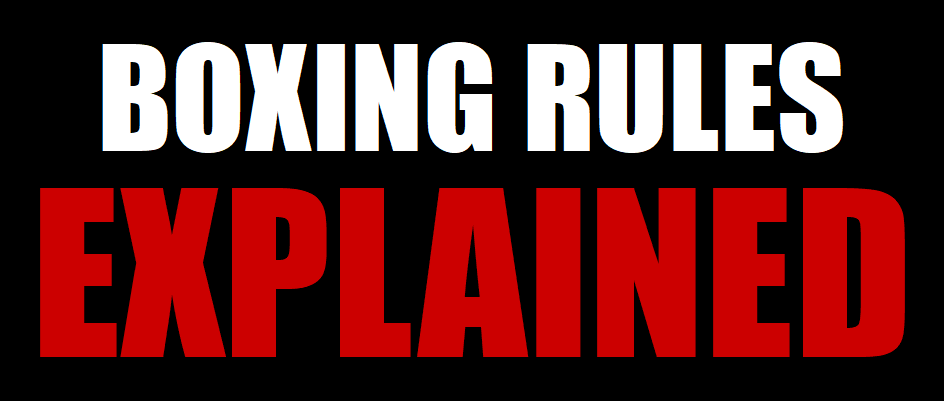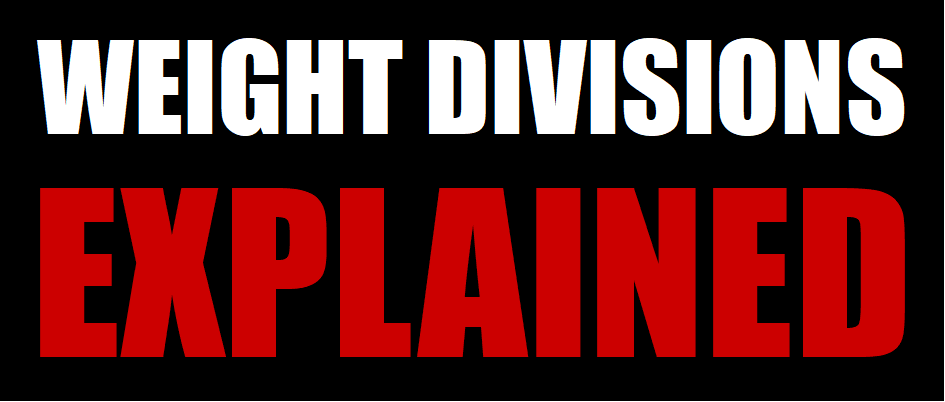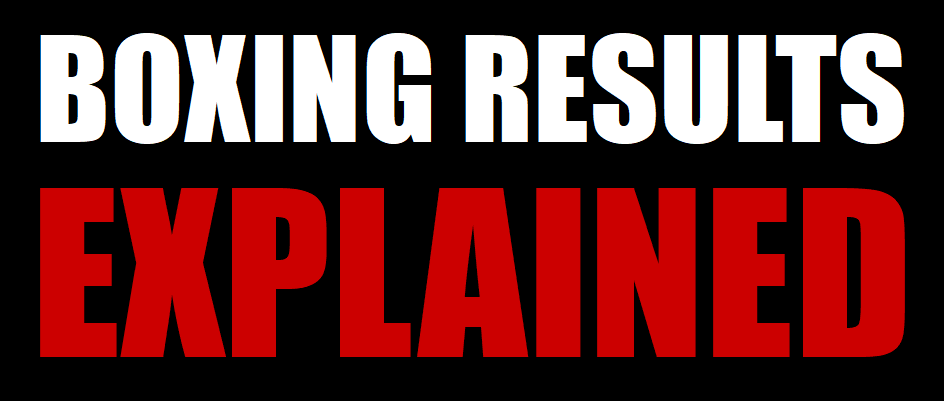A complete boxing words, terms & phrases glossary featuring every piece of lingo – here covering M, N and O. Just part of our huge Boxing FAQ.
Select a glossary section from below:
Words & Terms: M

Main Event
The fight most fight fans come to see; the biggest attraction on the fight card, and final to take place.
Making Weight
The act of losing enough body mass in order to ‘make weight’ prior to a boxing weigh-in. With the exception of Heavyweights, all boxers are obligated to make weight, with top prospects and champions typically doing so following 12-week training camps.
Majority Decision (MD)
An outcome reached following the final bell of a fight whereby one judge scored it even, and the other two for Boxer A. You can see an example of a Majority Decision, among other types of decisions, in our Boxing Results Explained Guide.
Majority Draw
A Majority Draw carries the same basic outcome as a Draw. Instead of all judges having identical scores, however, an MD occurs when two judges score the bout even, and the other for Boxer A.
Manager
Someone who manages a boxer (and may also act as their agent). A manager seeks publicity opportunities and works with promoters and agencies to arrange bouts and negotiate purses, among other matters for their client. One of modern boxing’s revered managers is Al Haymon, a highly influential figure with a huge roster of boxers.
Mandatory Defense/Challenger
A world champion may be obligated to fight a sanctioning body’s no.1-ranked challenger. For instance, the WBC informs John Smith that he must defend his title against top contender Joe Bloggs next. If John Smith declines, the title will be stripped/become voluntarily vacant.
Mandatory 8-Count
A count given to ensure a boxer has at least 8 seconds recovery time before resuming action after a knockdown. This was instated into boxing’s evolving rules as a safety measure, largely to prevent the fallen boxer’s opponent from immediately rushing them.
Marquess of Queensberry
The Scotsman, John Douglas, who endorsed a set of rules for contests in 1867. These boxing rules, which have been gradually developed and refined over the years, are imposed by most, if not all boxing commissions. It is a misconception that Douglas also wrote the rules; they were in fact written by Welshman, John Graham Chambers.
Mary Anne
A nickname boxers may give to their favorite or signature punch. For instance, Ryan Garcia’s famous counter left-hook could be called his Mary Anne.
Match
A fight, bout.
Matchmaker
Matchmaking is not always an individual profession; a manager, promoter, or boxer-promoter could undertake an additional matchmaking role. Matchmakers are responsible for creating boxing matchups, the pairing of two boxers that will share a ring.
Careful matchmaking is crucial for successful business; for example, if the matchmaker is looking for an opponent for a young, lucrative prospect, he must calculate a number of factors and risks. An example of arguably bad matchmaking 2008’s Amir Khan vs. Breidis Prescott, as Prescott was too dangerous for the young upstart Khan, who was quickly knocked out.
Oftentimes with top contenders and champions, risk and reward plays a large role in matchmaking. For instance, the young Danny Garcia took on considerable risk against Khan in 2012, but that risk eventually paid off big time for Garcia’s profile following a dramatic TKO victory.
Mauler
Or Slugger; a ‘mauler’ is characterized as a boxer who swarms his opponent using a barrage of vicious punches. Subtlety, patience, and oftentimes refined technique, are words outside of a mauler’s vocabulary.
Medicine Ball
A soccer-sized ball usually made of rubber or leather used as a training device. Boxers perform various exercises with these, such as slamming and throwing them to strengthen their shoulders, back and core. Trainers may also hit a boxer’s abdomen with them as a way of strengthening core muscles.
Memorial 10-Count
The chiming of a bell ten times prior to a fight to honor a recently deceased boxer or servant of boxing, such as a promoter, manager, trainer, or official.
Middleweight
A weight class whereby boxers must weigh-in at a maximum of 160 lbs/73kg.
Mini Flyweight
Or Light Flyweight, Junior Flyweight, Super Strawweight; boxer’s cannot exceed 108 lbs/49kg on the scales.
Minimumweight
Or Strawweight; the lowest weight a male boxer can campaign at, with a maximum limit of 105 lbs/48kg.
Mismatch
Simply a fight featuring an overmatched boxer, on paper, in reality, or both. Mismatches often displease audiences as they can end in early knockouts or by landslide Unanimous Decisions.
Mouse
Due to repeated blows, swelling under the eye/s can occur during a fight. A commenter might say that “John Smith has a mouse growing under his right eye.”
Mouthpiece/Mouthguard/Gumshield
A safety aid, usually made of thermoplastic, worn over a boxer’s top teeth to help prevent tooth loss and oral damage during a fight. All boxers use mouthpieces, and referees will usually halt a bout’s action if a boxer’s mouthpiece falls out/is knocked out.
Words & Terms: N
NABF
North American Boxing Federation; a professional sanctioning body who awards title belts to the victors of championship bouts.
Newspaper Decision
In the early 20th century, a No Contest bout may have been reported by a newspaper journalist as a different outcome; officially, however, the bout still remained a No Contest.
The reason papers reported different results was likely because they believed that it would help sell more copies, with a more dramatic, interesting boxing result considered more satisfying to read.
Neutral Corner
A corner of the ring which does not belong to either boxer. These corners are sometimes referred to as ‘white corners’ (the boxer’s corners being red and blue). A boxer who knocks down an opponent will be asked to go to a ‘neutral corner’ while the referee reads a 10-count to the felled boxer.
No Contest (NC)
A bout that is halted by the referee, which results in no winner or loser being declared due to an unusual circumstance which has taken place. You can find out about No Contests and other types of outcomes in our Boxing Results Explained Guide.
No Decision (ND)
The same as a No Contest (above).
No Mas
A statement synonymous with the boxer Roberto Duran, translating to English (from Spanish) as “No More”. The legendary boxer famously spoke these words when retiring himself from a rematch with rival Sugar Ray Leonard.
Not Being Able to Get Off
Refers to a boxer who cannot seem to find his rhythm and range to ‘get his punches off’ during a bout. This could be for a number of reasons, such as his timing being off or his opponent having an awkward style.
Novice
An inexperienced or inept boxer who poses little threat to top contenders and champions.
No.1 Contender
A boxer considered a champion’s most dangerous opponent, or one that stands the greatest chance of toppling him in their respective division. Sanctioning bodies and publications produce rankings to determine who top contenders should be.
Words & Terms: O
Official
A member of a sanctioning body, member of a state’s boxing commission, or appointed doctor present at a bout to ensure that safety, regulations and rules are implemented correctly.
Official Record
A boxer’s official fight record which contains wins (and those by knockout), losses, draws and no contests.
Old-Timer
Refers to a boxer who has seen better days in the ring, but continues his fighting career despite showing signs of decline, typically in regards to speed, reflexes and punch resistance.
One-Punch Knockout
Simply a knockdown or knockout resulting from a powerful single punch. Manny Pacquiao knockout out Ricky Hatton with a single punch in 2009, and Carl Froch quickly closed the show against George Groves in their 2014 rematch.
One-Two (combination)
Refers to a textbook combination consisting of a jab (lead) quickly followed by a right (rear) hand. Also known as a left-right combination.
On the Back Foot
A boxer who is said to be ‘on the back foot’ is generally retreating from an attack, but the term can also refer to a defensively-minded boxer looking to counter an aggressive opponent. Floyd Mayweather was often seen on the back foot, but was very adept with this style, able to effectively box and counter advancing opponents.
On the Button
A commentator may reflect on a knockout by stating that “the shot caught him right on the button”, generally referring to the tip of a boxer’s chin – an area susceptible to high damage.
On the Ropes
When a boxer is literally on the ropes, considered a vulnerable place to be. While being on the ropes can sometimes be a strategic move, oftentimes a boxer finds himself trapped on the ropes by an aggressive opponent.
Opening
This refers to an opening to land a punch. For instance, John Smith may notice that his opponent drops his right glove when throwing a jab, so Smith may decide to counter with a left-hook.
Open Scoring
Though uncommon, open scoring means judges’ scorecards are tallied at the end of each round and revealed to boxers and the audience throughout the fight. The system has its advocates and detractors.
Out for the Count
A term often used to describe a boxer who has been knocked out cold, or stands next to no chance of beating the referee’s 10-count. Roberto Duran was out for the count after rival Thomas Hearns delivered a devastating blow in 1984.
Outgunned
Refers to a boxer who is being picked off, out-landed, and overpowered by a stronger or more skilled opponent.
Outmuscled
Refers to a moment in a bout where a boxer is being physically overwhelmed by a stronger opponent. It does not necessarily mean that he is getting punched harder, but is more so struggling to control his opponent during clinches and close-quarter action.
An outmuscled boxer may become increasingly fatigued if a stronger opponent uses his bigger frame to, for example, lean on and push their head down during clinches. Tyson Fury notably ‘outmuscled’ and roughed up Deontay Wilder in their 2019 and 2021 rematches.
Outpoint
To outpoint an opponent; this refers to professional bouts which are scored on telling blows and ring generalship, and also Amateur bouts which are solely scored on clean connects.
Outside Fighter
As described below; Outside Fighters try to not overstay their welcome inside the pocket (danger/punch zone), especially when facing a heavy puncher.
Outside Fighting
Quite the reverse of Infighting. Outside fighting occurs when a boxer keeps a safer distance from his opponent, and controls the pace often through straight punches and frequent jabs.
Orthodox (stance)
A stance adopted by boxers who fight with their left foot forward. Conversely, one who leads with his right foot is a called a Southpaw. Some boxers are effective in both stances and may switch at any given time during a fight to suit the situation; this is known as Switch-Hitting.
Orthodox (style)
Generally speaking, an orthodox style is characterized by a boxer who maintains a high guard, tucks in their chin and throws textbook shots and combinations. It may be said that they do everything by the book.
The legendary Joe Louis is considered a great disciple of orthodox boxing. Conversely, an unorthodox style boxer may keep his hands at his waist and leave his chin up, relying on reflexes and instinct over conventional form.
Overhand
A high punch thrown to an opponent’s head, often while using lateral movement. Ruslan Provodnikov used overhand right-counters to great effect in the early stages of his title fight against Timothy Bradley.
Overmatched
Or outclassed; refers to an opponent who’s out of his opponent’s league. Most young prospects’ first 10-15 opponents are usually heavily overmatched.
Overtraining
It’s crucial that a boxer and his trainer get the balance right in training. While under-training is of course foolish, overtraining can be equally as detrimental, leading to fatigue, injury and sickness. For example, overtraining may impact a boxer’s fight night performance due to excessive weight loss or muscle soreness.
Outclassed
Or overmatched; used to describe a boxer who, due to limited skill, is being picked off or heavily beaten by his opponent. Although Chuck Wepner almost went the distance with Muhammad Ali in 1975, he was heavily outclassed in the pairs’ bout.
Select a glossary section from below:
Return to Boxing FAQ?






